The Effects of Colour Content and Cumulative Area of Outdoor Advertisement Billboards on the Visual Quality of Urban Streets
Abstract
1. Introduction
Research Background
2. Materials and Methods
2.1. Description of the Study Site
2.2. Data Collection
2.3. Field Work
2.4. Data Analysis Techniques
2.4.1. Pictorial Analysis
2.4.2. RGB Analysis Using RGB Histogram
2.4.3. Areal Cumulative Analysis (ACA)
2.5. Sampling Design and Analysis
3. Results
3.1. Respondents’ Demographic Analysis and Normality of Distribution
3.2. Areal Cumulative Analysis Results
3.3. Cross-Sectional Analysis between RGB Content and Subjects’ Responses
3.4. The Difference in Response to Visual Pollution Based on Demographic Group
4. Discussion
5. Conclusions
Author Contributions
Funding
Data Availability Statement
Conflicts of Interest
References
- Chmielewski, S.; Samulowska, M.; Lupa, M.; Lee, D.J.; Zagajewski, B. Citizen Science and Webgis for Outdoor Advertisement Visual Pollution Assessment. Comput. Environ. Urban Syst. 2018, 67, 97–109. [Google Scholar] [CrossRef]
- Wakil, K.; Tahir, A.; Hussnain, M.Q.U.; Waheed, A.; Nawaz, R. Mitigating Urban Visual Pollution Through a Multistakeholder Spatial Decision Support System to Optimize Locational Potential of Billboards. ISPRS Int. J. Geo Inf. 2021, 10, 60. [Google Scholar] [CrossRef]
- Dulaimi, S.A.M.A. Visual pollution in Fallujah city. J. Univ. Anbar Humanit. 2021, 7, 289–310. [Google Scholar]
- Alwah, A.A.Q.; Li, W.; Alwah, M.A.Q.; Drmoush, A.A.K.; Shahrah, S.; Tran, D.T.; Xi, L.B. Difficulty and Complexity in Dealing with Visual Pollution in Historical Cities: The Historical City of Ibb, Yemen as A Case Study. In Proceedings of the International Workshop on Green Energy, Environment and Sustainable Development, Weihai, China, 28–30 August 2020; IOP Conference Series: Earth and Environmental Science. IOP Publishing: Bristol, UK, 2020; Volume 601, p. 012045. [Google Scholar]
- Chmielewski, S.; Lee, D.J.; Tompalski, P.; Chmielewski, T.J.; Wężyk, P. Measuring Visual Pollution by Outdoor Advertisements in An Urban Street Using Intervisibilty Analysis and Public Surveys. Int. J. Geogr. Inf. Sci. 2016, 30, 801–818. [Google Scholar] [CrossRef]
- Bakar, S.A.; al-Sharaa, A.; Maulan, S.; Munther, R. Measuring Visual Pollution Threshold along Kuala Lumpur Historic Shopping District Streets Using Cumulative Area Analysis. In Visual Resource Stewardship Conference; SUNY College of Environmental Science and Forestry: Syracuse, NY, USA, 2019. [Google Scholar]
- Szczepańska, M.; Wilkaniec, A.; Škamlová, L. Visual Pollution in Natural and Landscape Protected Areas: Case Studies From Poland And Slovakia. Quaest. Geogr. 2019, 38, 133–149. [Google Scholar] [CrossRef]
- Engel, N.L. Highway to the Safety Zone: Why the Highway Beautification Act Should Be Repealed and Its Federal Oversight Power Transferred to the States. Ohio St. LJ 2021, 82, 1141. [Google Scholar]
- Mohamed, M.A.S.; Ibrahim, A.O.; Dodo, Y.A.; Bashir, F.M. Visual Pollution Manifestations Negative Impacts on The People of Saudi Arabia. Int. J. Adv. Appl. Sci. 2021, 8, 94–101. [Google Scholar]
- Khanal, K.K. Visual Pollution and Eco-Dystopia: A Study of Billboards and Signs in Bharatpur Metropolitan City. Res. J. Engl. Lang. Lit 2018, 6, 202–208. [Google Scholar]
- Wang, Y.; Clifford, W.; Markham, C.; Deegan, C. Examination of Driver Visual and Cognitive Responses to Billboard Elicited Passive Distraction Using Eye-Fixation Related Potential. Sensors 2021, 21, 1471. [Google Scholar] [CrossRef]
- Sheykhfard, A.; Haghighi, F. Driver Distraction by Digital Billboards? Structural Equation Modeling Based on Naturalistic Driving Study Data: A Case Study of Iran. J. Saf. Res. 2020, 72, 1–8. [Google Scholar] [CrossRef]
- Thomas, J. Remove Billboards for The Sake of Our Mental Health. Available online: https://www.thenational.ae/opinion/remove-.billboards-for-the-sake-of-our-mental-health-1.112238 (accessed on 12 August 2019).
- Mikołajczak-Degrauwe, K.; Brengman, M. The Influence of Advertising on Compulsive Buying—The Role of Persuasion Knowledge. J. Behav. Addict. 2014, 3, 65–73. [Google Scholar] [CrossRef] [PubMed]
- Basch, C.H.; Ethan, D.; LeBlanc, M.; Basch, C.E. A description of advertisements for alcohol on LinkNYC kiosks in Manhattan, New York City: A pilot study. J. Community Health 2018, 43, 787–791. [Google Scholar] [CrossRef] [PubMed]
- Mundher, R.; Abu Bakar, S.; Maulan, S.; Mohd Yusof, M.J.; Osman, S.; Al-Sharaa, A.; Gao, H. Exploring Awareness and Public Perception Towards the Importance of Visual Aesthetics for Preservation of Permanent Forest Reserve (PFR) in Malaysia. Land 2022, 11, 1280. [Google Scholar] [CrossRef]
- Mundher, R.; Abu Bakar, S.; Maulan, S.; Mohd Yusof, M.J.; Al-Sharaa, A.; Aziz, A.; Gao, H. Aesthetic Quality Assessment of Landscapes as a Model for Urban Forest Areas: A Systematic Literature Review. Forests 2022, 13, 991. [Google Scholar] [CrossRef]
- Cvetković, M.; Momčilović–Petronijević, A.; Ćurčić, A. Visual Pollution of Urban Areas as one of the Main Issues of the 21st Century. In Proceedings of the 26th International Conference Ecological Truth & Environmental Research, Sokobanja, Serbia, 21–24 June 2018; pp. 12–15. [Google Scholar]
- Syrbe, R.U.; Neumann, I.; Grunewald, K.; Brzoska, P.; Louda, J.; Kochan, B.; Bastian, O. The Value of Urban Nature in Terms of Providing Ecosystem Services Related to Health and Well-Being: An Empirical Comparative Pilot Study of Cities in Germany and the Czech Republic. Land 2021, 10, 341. [Google Scholar] [CrossRef]
- Mundher, R.; Al-Sharaa, A.; Al-Helli, M.; Gao, H.; Abu Bakar, S. Visual Quality Assessment of Historical Street Scenes: A Case Study of the First “Real” Street Established in Baghdad. Heritage 2022, 5, 192. [Google Scholar] [CrossRef]
- Tang, J.; Long, Y. Measuring visual quality of street space and its temporal variation: Methodology and its application in the Hutong area in Beijing. Landsc. Urban Plan. 2019, 191, 103436. [Google Scholar] [CrossRef]
- Santosa, H.; Ernawati, J.; Wulandari, L.D. Visual quality evaluation of urban commercial streetscape for the development of landscape visual planning system in provincial street corridors in Malang, Indonesia. In Proceedings of the Friendly City 4 ‘From Research to Implementation For Better Sustainability’, Medan, Indonesia, 11–12 October 2017; IOP Conference Series: Earth and Environmental Science. IOP Publishing: Bristol, UK, 2018; 126. [Google Scholar]
- Kalantari, S.; Tripathi, V.; Kan, J.; Rounds, J.D.; Mostafavi, A.; Snell, R.; Cruz-Garza, J.G. Evaluating the Impacts of Color, Graphics, And Architectural Features on Wayfinding in Healthcare Settings Using EEG Data and Virtual Response Testing. J. Environ. Psychol. 2022, 79, 101744. [Google Scholar] [CrossRef]
- Qin, X.; Zhang, N.; Zhang, W.; Meitner, M. How Does Tunnel Interior Color Environment Influence Driving Behavior? Quantitative Analysis and Assessment Experiment. Tunn. Undergr. Space Technol. 2020, 98, 103320. [Google Scholar]
- Al-Sharaa, A.; Adam, M.; Amer Nordin, A.S.; Alhasan, A.; Mundher, R. A User-Centered Evaluation of Wayfinding in Outpatient Units of Public Hospitals in Malaysia: UMMC as a Case Study. Buildings 2022, 12, 364. [Google Scholar] [CrossRef]
- Peralta, A.; Fernández-Caballero, A.; Latorre, J.M. Determining the Ambient Influences and Configuration of Optimised Environments for Emotional Wellbeing of Older Adults. Ergonomics 2021, 64, 1146–1159. [Google Scholar] [CrossRef]
- Bianconi, F.; Fernández, A.; Smeraldi, F.; Pascoletti, G. Colour and Texture Descriptors for Visual Recognition: A Historical Overview. J. Imaging 2021, 7, 245. [Google Scholar] [CrossRef] [PubMed]
- Xu, Z.; Zheng, X. Roadmap of Moving Urban Colour Toward Cultural Sustainability in China. Color Res. Appl. 2021, 46, 222–239. [Google Scholar] [CrossRef]
- Abdelhamid, M.M. An Attempt to Reduce Visual Pollution in the Building Sector within Egyptian Cities. Spaces Flows Int. J. Urban Extra Urban Stud. 2018, 9, 3–34. [Google Scholar] [CrossRef]
- Achsani, R.A.; Wonorahardjo, S. Studies on Visual Environment Phenomena of Urban Areas: A Systematic Review. In Proceedings of the HABITechno 4th International Conference. Design for Inclusive and Habitable Transit Oriented Development Area, Bandung, Indonesia, 16 November 2019; IOP Conference Series: Earth and Environmental Science. IOP Publishing: Bristol, UK, 2020; Volume 532, p. 012016. [Google Scholar]
- Nami, P.; Jahanbakhsh, P.; Fathalipour, A. The Role and Heterogeneity of Visual Pollution on the Quality of Urban Landscape Using GIS.; Case Study: Historical Garden in City of Maraqeh. Open J. Geol. 2016, 6, 20–29. [Google Scholar] [CrossRef][Green Version]
- Cubukcu, E.; Ozcan, N.S.; Ozkan, A. The Influence of Commercial Sign Design and Space Invasion on Environmental Aesthetic Evaluations of Commercial Street: An Empirical Study Using Virtual Environments. Erciyes Univ. J. Inst. Sci. Technol. 2014, 30, 1–11. [Google Scholar]
- Gehl, J.; Kaefer, L.J.; Reigstad, S. Close Encounters with Buildings. Urban Des. Int. 2006, 11, 29–47. [Google Scholar] [CrossRef]
- Tabadkani, A.; Shoubi, M.V.; Soflaei, F.; Banihashemi, S. Integrated Parametric Design of Adaptive Facades for User’s Visual Comfort. Autom. Constr. 2019, 106, 102857. [Google Scholar] [CrossRef]
- Li, J.; Jin, Y.; Lu, S.; Wu, W.; Wang, P. Building Environment Information and Human Perceptual Feedback Collected Through a Combined Virtual Reality (VR) And Electroencephalogram (EEG) Method. Energy Build. 2020, 224, 110259. [Google Scholar] [CrossRef]
- Al-Sharaa, A.; Adam, M.; Nordin, A.S.A.; Alhasan, A.; Mundher, R.; Zaid, O. Enhancing Wayfinding Performance in Existing Healthcare Facilities Using Virtual Reality Environments to Revise the Distribution of Way-Showing Devices. Buildings 2022, 12, 790. [Google Scholar] [CrossRef]
- Wakil, K.; Naeem, M.A.; Anjum, G.A.; Waheed, A.; Thaheem, M.J.; Hussnain, M.Q.U.; Nawaz, R. A Hybrid Tool for Visual Pollution Assessment in Urban Environments. Sustainability 2019, 11, 2211. [Google Scholar] [CrossRef]
- Chmielewski, S. Chaos in Motion: Measuring Visual Pollution with Tangential View Landscape Metrics. Land 2020, 9, 515. [Google Scholar] [CrossRef]
- Chmielewski, S. Towards managing visual pollution: A 3-D Isovist and voxel approach to advertisement Billboard Visual Impact Assessment. ISPRS Int. J. Geo Inf. 2021, 10, 656. [Google Scholar] [CrossRef]
- Wakil, K.; Naeem, M.A.; Anjum, G.A.; Waheed, A.; Thaheem, M.J.; Hussnain, M.Q. The Assessment and Mapping of Urban Visual Pollution Through an Assembly of Open-Source Geospatial Tools. In Proceedings of the Real Corp 2019, Karlsruhe, Germany, 2–4 April 2019; pp. 723–730. [Google Scholar]
- De Oliveira, J.D.; Biondi, D.; dos Reis, A.R.N.; Viezzer, J. Landscape Visual Quality Influence on Noise Pollution Propagation in Urban Green Areas. Dyna 2021, 88, 131–138. [Google Scholar] [CrossRef]
- Mandeli, K. Public space and the challenge of urban transformation in cities of emerging economies: Jeddah case study. Cities 2019, 95, 102409. [Google Scholar] [CrossRef]
- Verma, D.; Jana, A.; Ramamritham, K. Predicting human perception of the urban environment in a spatiotemporal urban setting using locally acquired street view images and audio clips. Build. Environ. 2020, 186, 107340. [Google Scholar] [CrossRef]
- Petropoulos, Z.E.; Levy, J.I.; Scammell, M.K.; Fabian, M.P. Characterizing community-wide housing attributes using georeferenced street-level photography. J. Expo. Sci. Environ. Epidemiol. 2020, 30, 299–308. [Google Scholar] [CrossRef]
- Paikan, E.; Pourjafar, M.R.; Ranjbar, E. The Effects of Physical-Spatial Measures of Urban Streets on Pedestrians Emotional Responses Using EEG. Motaleate Shahri 2022, 11, 47–62. [Google Scholar]
- Simpson, J.; Freeth, M.; Simpson, K.J.; Thwaites, K. Visual engagement with urban street edges: Insights using mobile eye-tracking. J. Urban. Int. Res. Placemaking Urban Sustain. 2019, 12, 259–278. [Google Scholar] [CrossRef]
- Maruhn, P.; Dietrich, A.; Prasch, L.; Schneider, S. Analyzing pedestrian behavior in augmented reality—proof of concept. In Proceedings of the 2020 IEEE Conference on Virtual Reality and 3D User Interfaces (VR) IEEE, Atlanta, GA, USA, 22–26 March 2020; pp. 313–321. [Google Scholar]
- Ye, Y.; Zeng, W.; Shen, Q.; Zhang, X.; Lu, Y. The visual quality of streets: A human-centred continuous measurement based on machine learning algorithms and street view images. Environ. Plan. B Urban Anal. City Sci. 2019, 46, 1439–1457. [Google Scholar] [CrossRef]
- Al-Sharaa, A.; Adam, M.; Amer Nordin, A.S.; Mundher, R.; Alhasan, A. Assessment of Wayfinding Performance in Complex Healthcare Facilities: A Conceptual Framework. Sustainability 2022, 14, 16581. [Google Scholar] [CrossRef]
- Mundher, R.; Abu Bakar, S.; Al-Helli, M.; Gao, H.; Al-Sharaa, A.; Mohd Yusof, M.J.; Maulan, S.; Aziz, A. Visual Aesthetic Quality Assessment of Urban Forests: A Conceptual Framework. Urban Sci. 2022, 6, 79. [Google Scholar] [CrossRef]
- Ujang, N.; Moulay, A.; Zakaria, J. Visitors’ Attachment to Historic Tourism Places in Kuala Lumpur City Centre Towards Sustainable Urban Regeneration. Environ. Behav. Proc. J. 2018, 3, 165–172. [Google Scholar] [CrossRef]
- Mahalingam, E. The Most Expensive Real Estate. Business News. The Star Online. Available online: https://www.thestar.com.my/business/business-news/2014/06/07/the-most-expensive-real-estatesome-properties-in-jalan-tar-fetch-extremely-high-rentals/ (accessed on 12 June 2019).
- Lim, I. KL Mayor: Minister to Meet Traders on Jalan TAR Closure Plans. Malaymail. Available online: https://www.malaymail.com/news/malaysia/2019/02/16/kl-mayor-minister-to-meet-traders-on-jalan-tar-closure-plans/1723588 (accessed on 12 June 2019).
- Pare, S.; Kumar, A.; Singh, G.K.; Bajaj, V. Image segmentation using multilevel thresholding: A research review. Iranian J. Sci. Technol. Trans. Electr. Eng. 2020, 44, 1–29. [Google Scholar]
- Gravetter, F.J.; Wallnau, L.B.; Forzano, L.A.B.; Witnauer, J.E. Essentials of Statistics for the Behavioral Sciences; Cengage Learning: Boston, MA, USA, 2020. [Google Scholar]
- Ahmed, N.; Islam, M.N.; Tuba, A.S.; Mahdy, M.R.C.; Sujauddin, M. Solving Visual Pollution with Deep Learning: A New Nexus in Environmental Management. J. Environ. Manag. 2019, 248, 109253. [Google Scholar] [CrossRef] [PubMed]
- Huang, Z.; Liu, Q.; Liu, Y.; Pointer, M.; Bodrogi, P.; Khanh, T.Q.; Liu, A. Gender Difference in Colour Preference of Lighting: A Pilot Study. Light Eng. 2020, 28, 111–122. [Google Scholar] [CrossRef]
- Lienemann, B.A.; Rose, S.W.; Unger, J.B.; Meissner, H.I.; Byron, M.J.; Baezconde-Garbanati, L.; Cruz, T.B. Tobacco Advertisement Liking, Vulnerability Factors, And Tobacco Use Among Young Adults. Nicotine Tob. Res. 2019, 21, 300–308. [Google Scholar] [CrossRef]
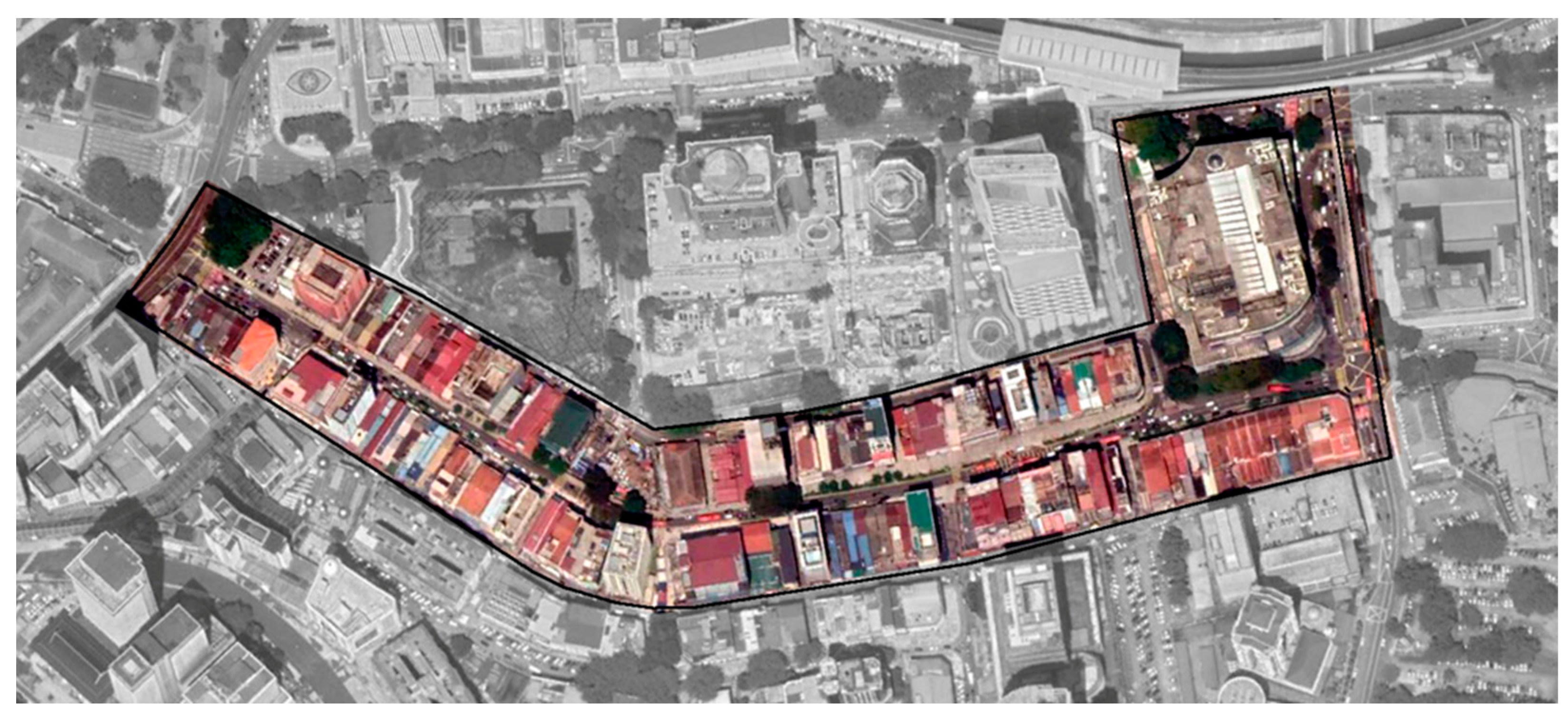
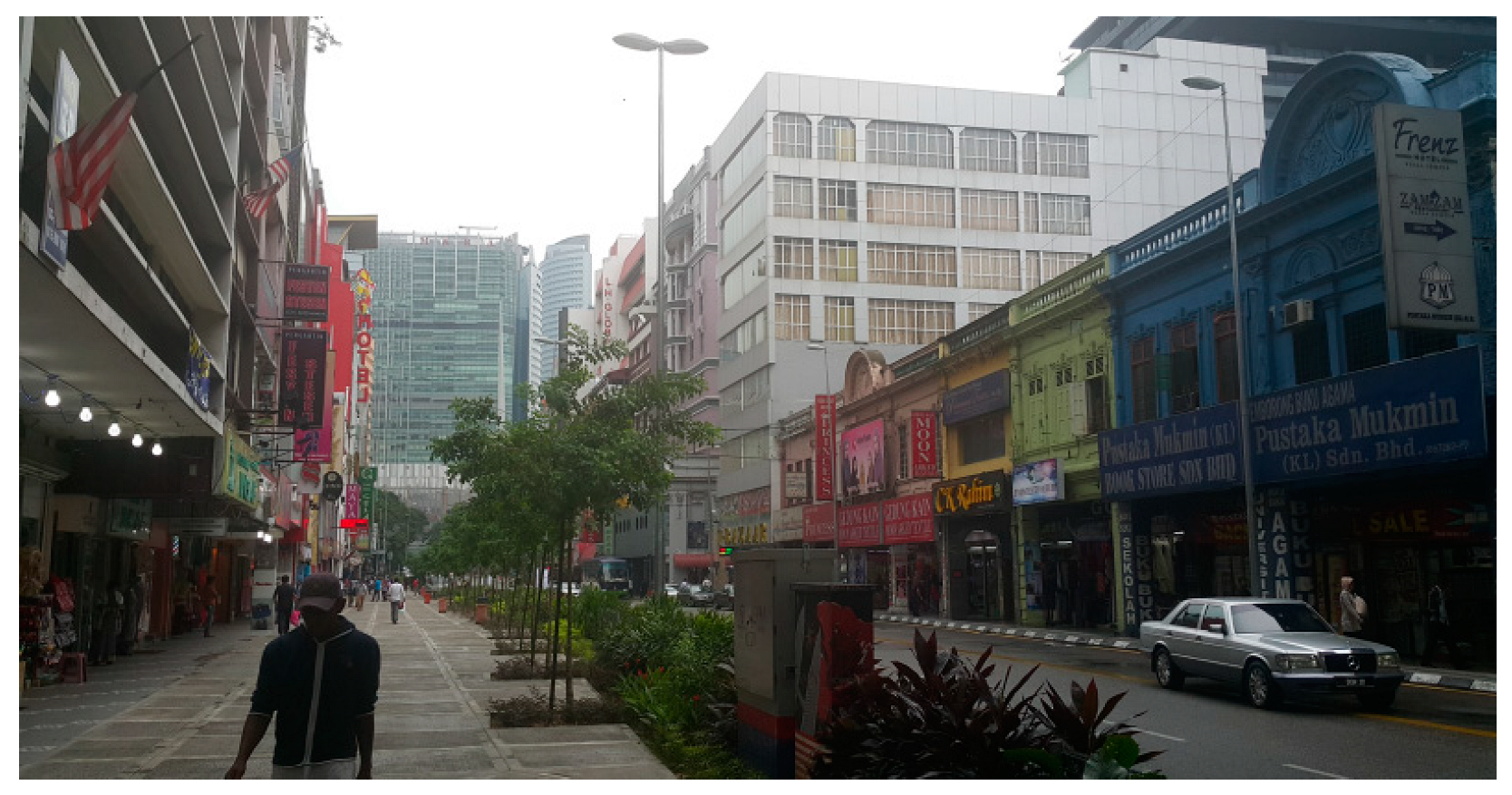
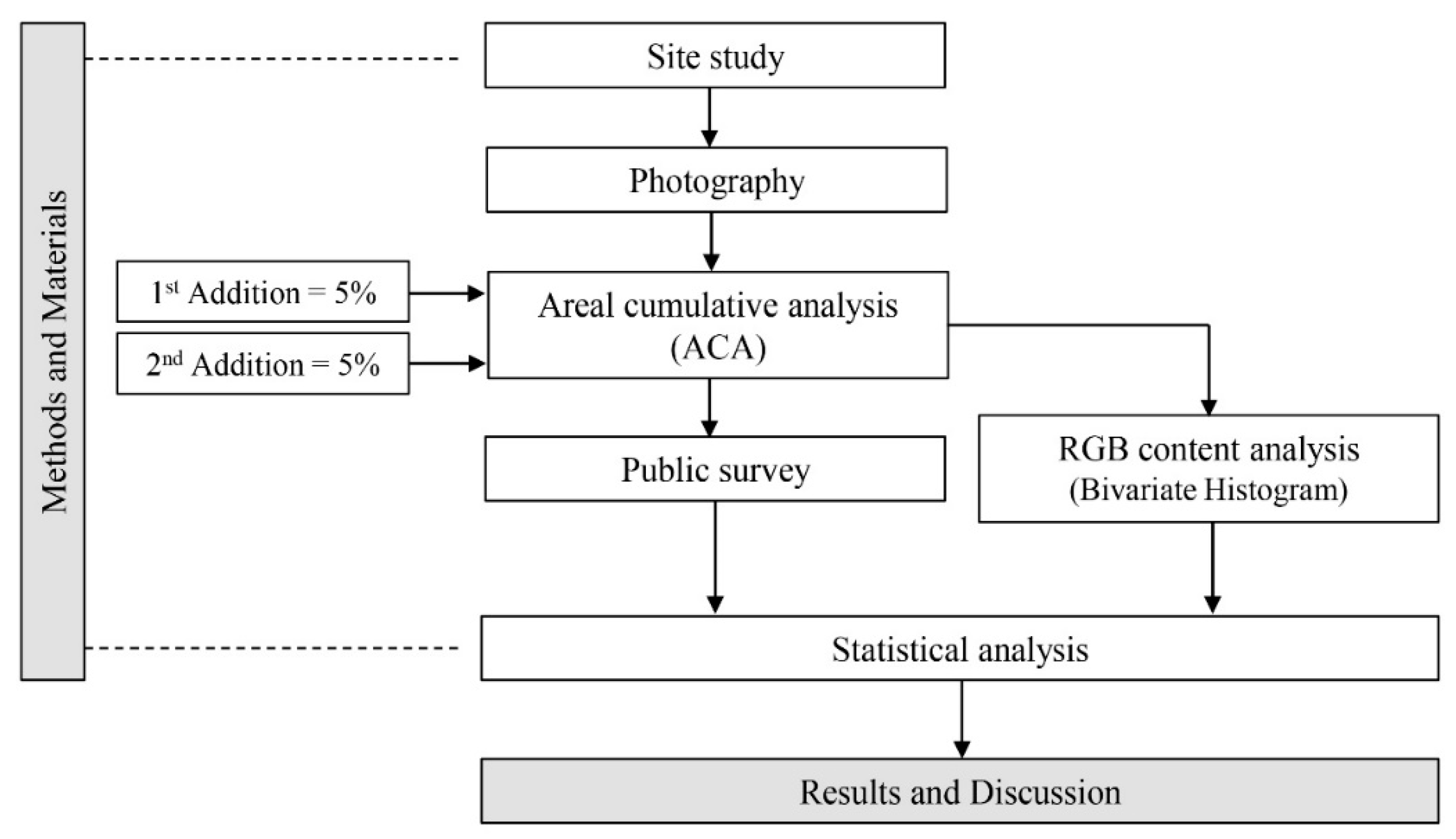
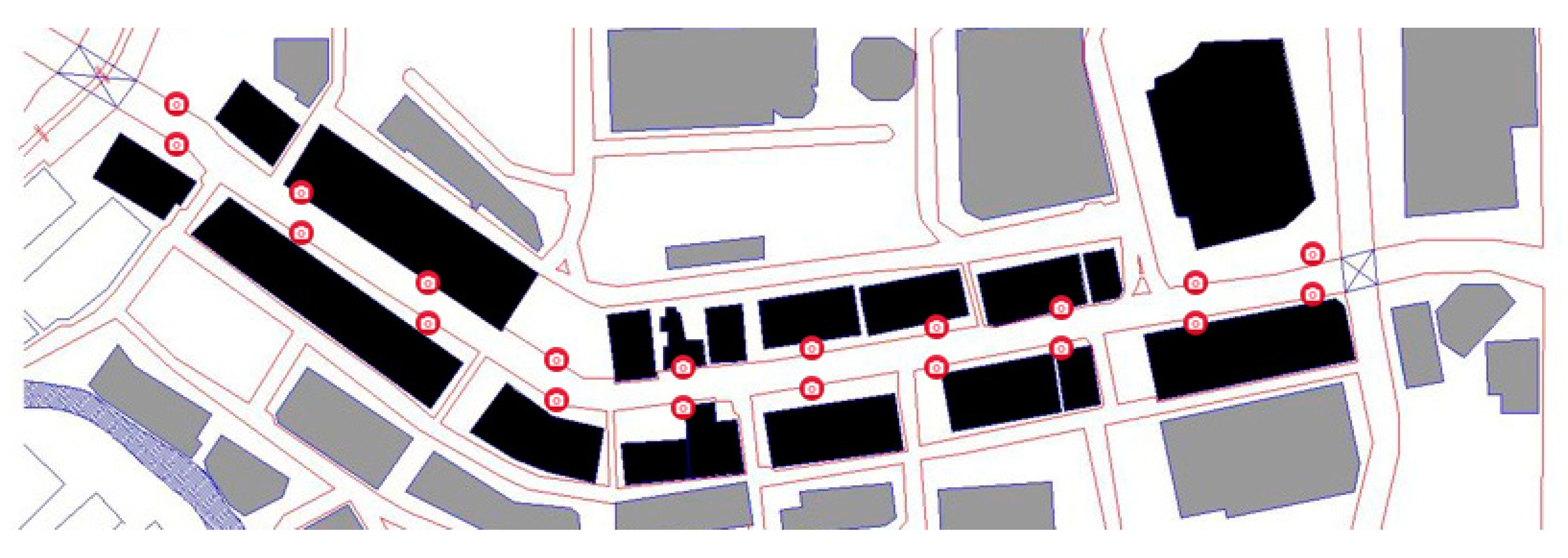
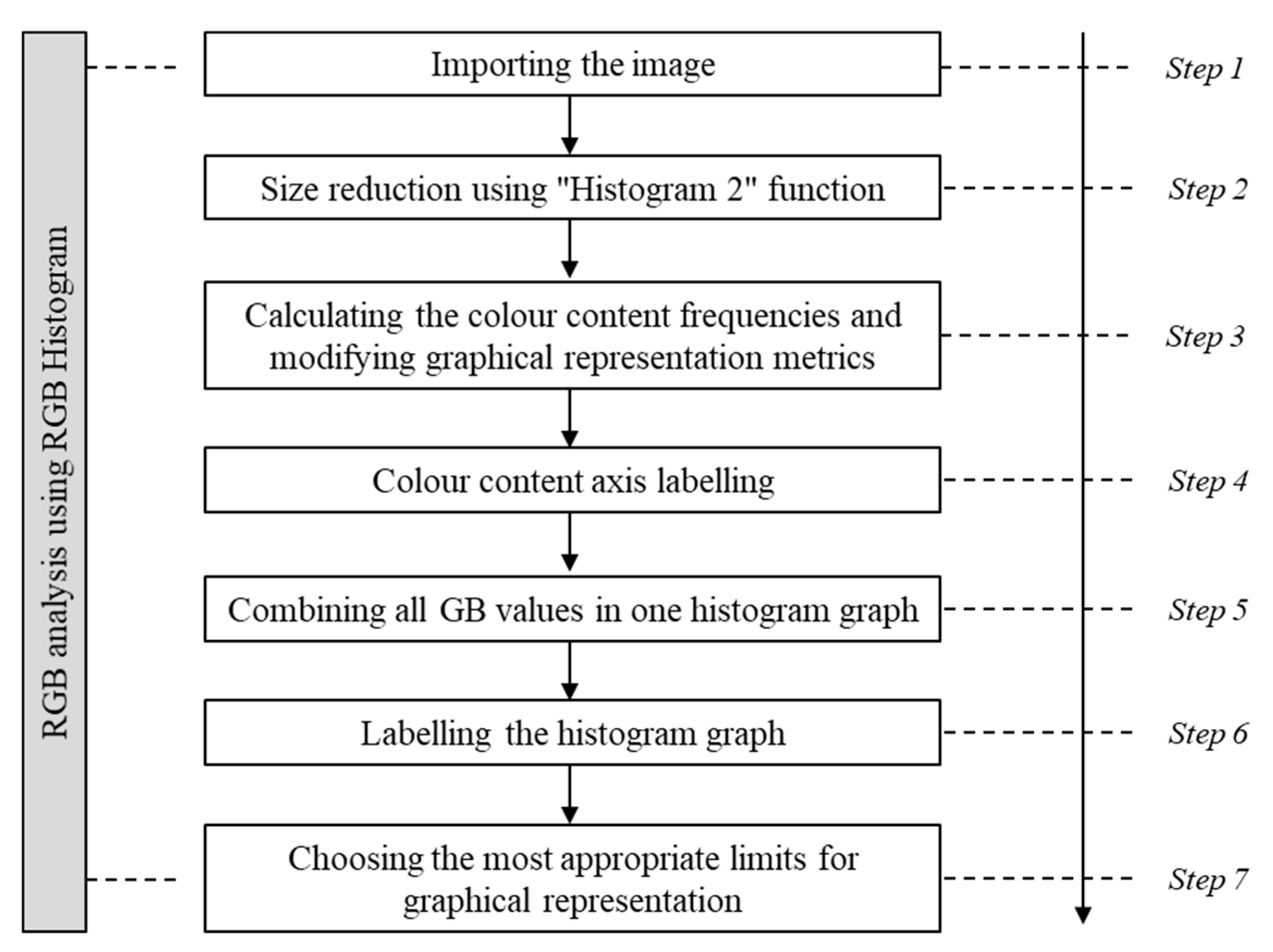
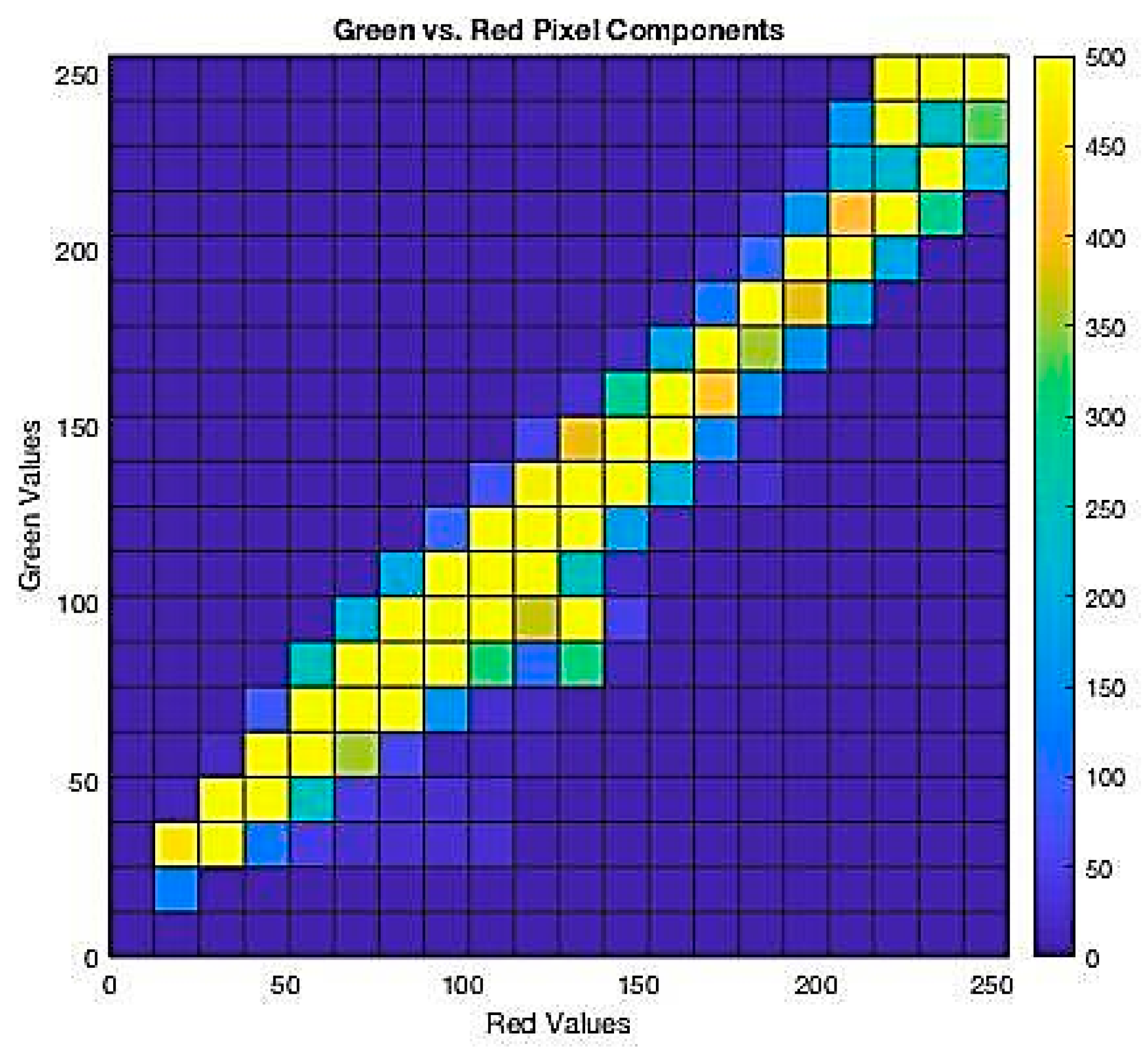
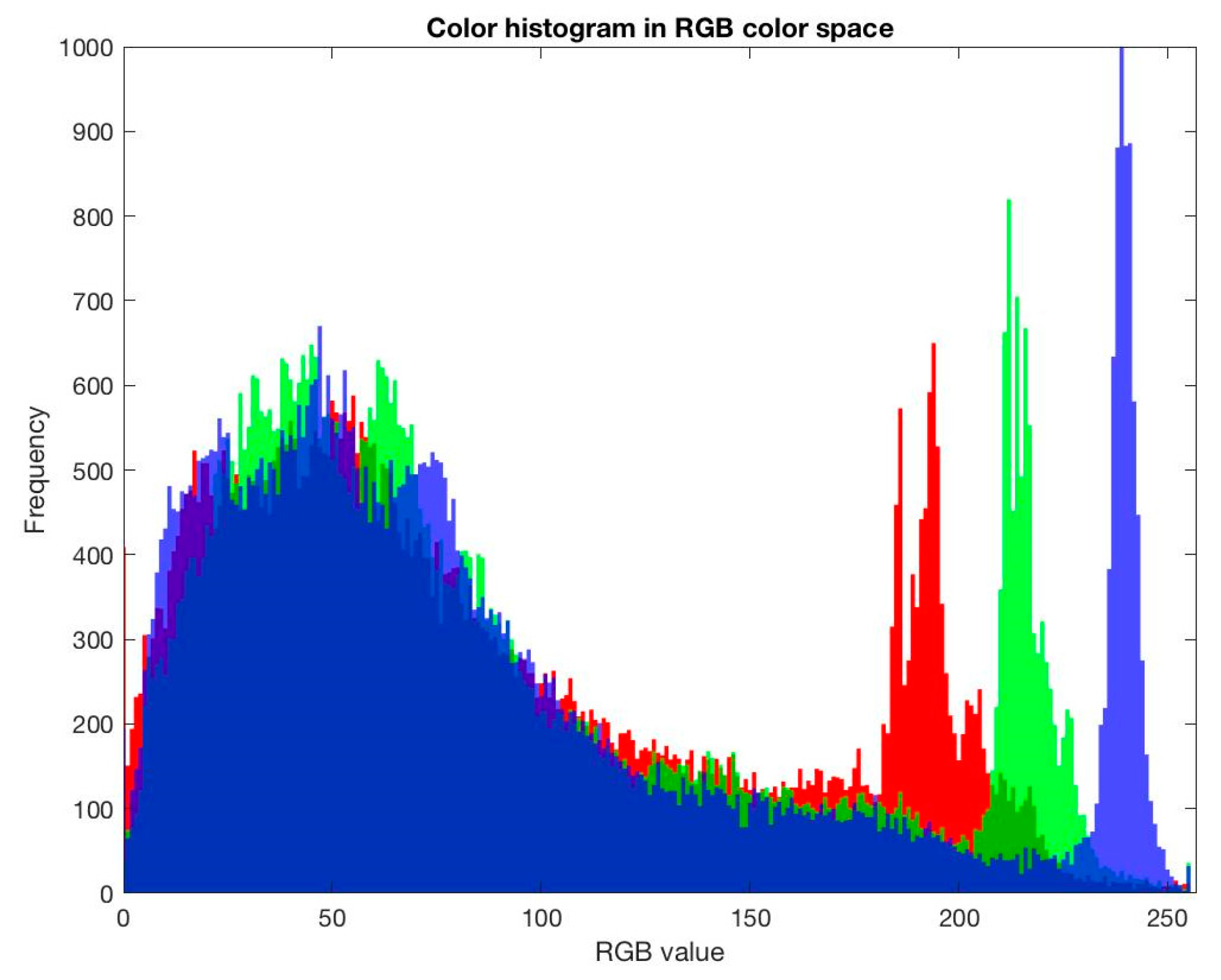
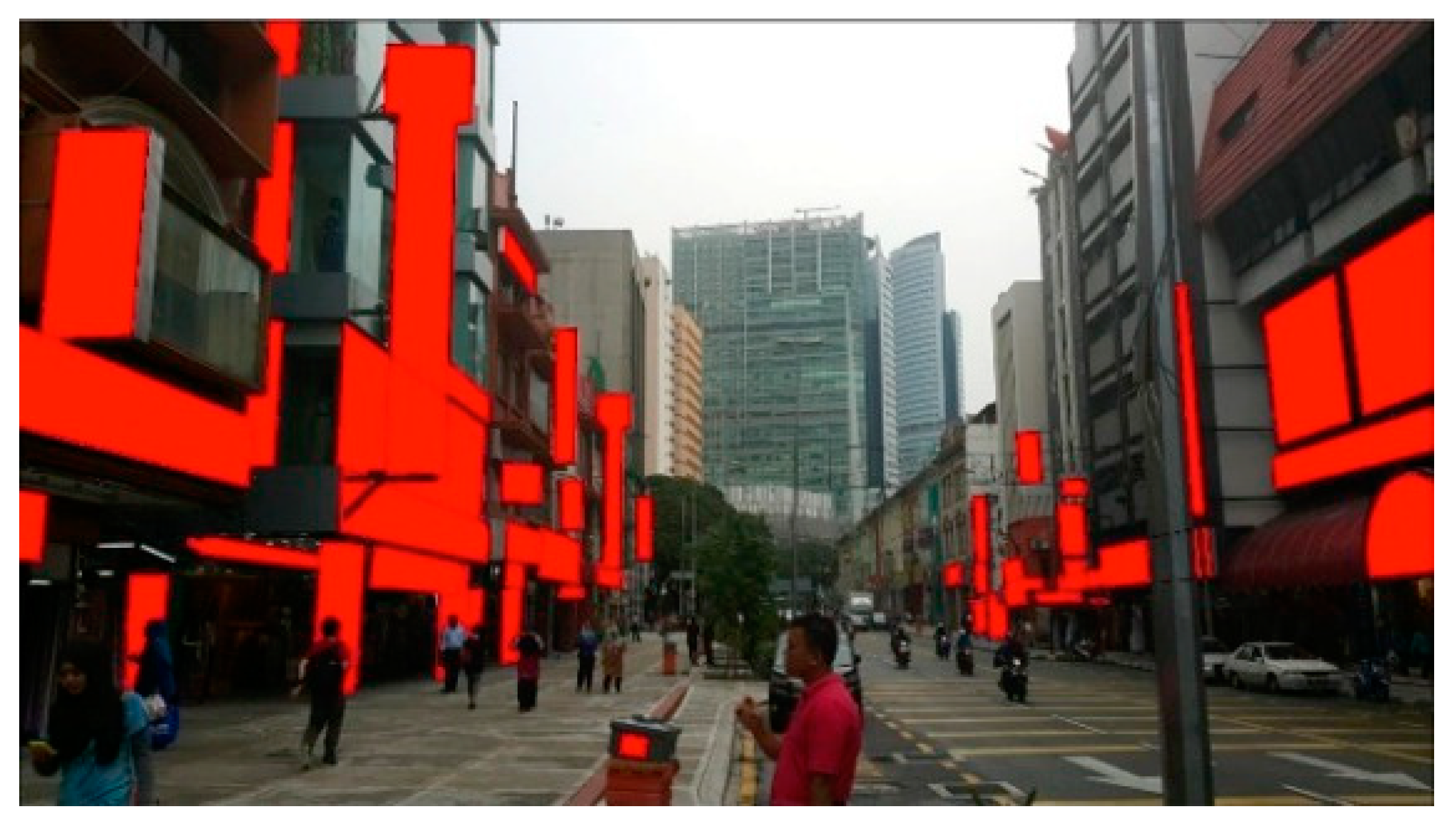
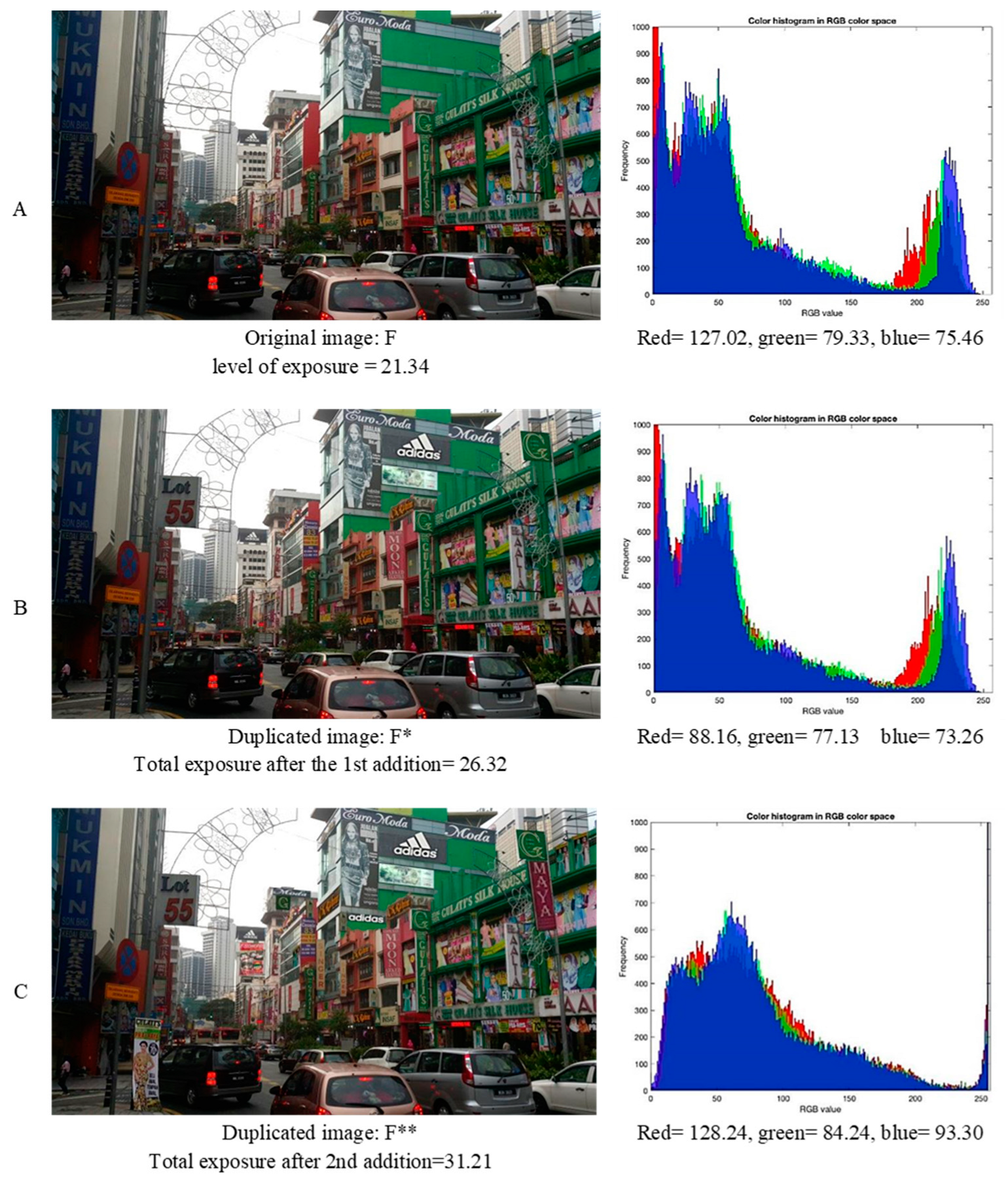
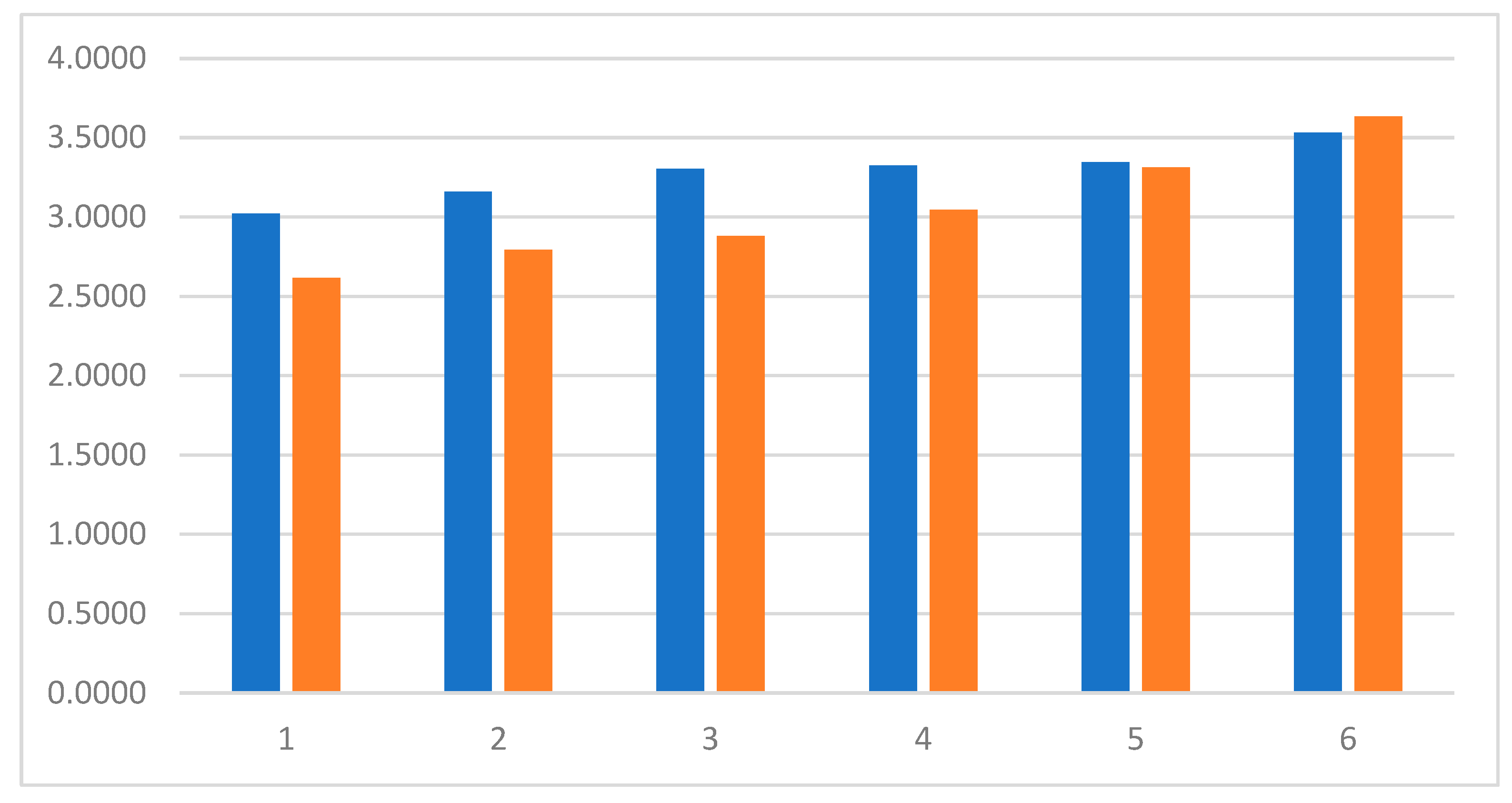
| Picture | Code | Existing Level of Exposure % | Picture | Code | Existing Level of Exposure % |
|---|---|---|---|---|---|
| 1 | A | 16.27 | 8 | H | 14.66 |
| 2 | B | 17.28 | 9 | I | 1.42 |
| 3 | C | 11.79 | 10 | J | 2.16 |
| 4 | D | 10.65 | 11 | K | 0.82 |
| 5 | E | 11.08 | 12 | L | 7.00 |
| 6 | F | 21.34 | 13 | M | 6.85 |
| 7 | G | 10.13 | 14 | N | 3.68 |
| Existing | After 1st Addition | After 2nd Addition | ||||||
|---|---|---|---|---|---|---|---|---|
| Code | Level of Exposure % | No. of OAs | Code * | Level of Exposure % | No. of OAs | Code ** | Level of Exposure % | No. of OAs |
| A | 16.27 | 51 | A * | 21.23 | 54 | A ** | 26.09 | 62 |
| B | 17.28 | 36 | B * | 22.39 | 42 | B ** | 27.43 | 54 |
| C | 11.79 | 45 | C * | 16.69 | 53 | C ** | 21.59 | 59 |
| D | 10.65 | 45 | D * | 15.55 | 51 | D ** | 20.56 | 57 |
| E | 11.08 | 43 | E * | 16.08 | 49 | E ** | 20.98 | 59 |
| F | 21.34 | 54 | F * | 26.32 | 62 | F ** | 31.21 | 78 |
| G | 10.13 | 26 | G * | 15.26 | 30 | G ** | 20.38 | 46 |
| H | 14.66 | 34 | H * | 19.67 | 39 | H ** | 24.64 | 31 |
| I | 1.42 | 10 | I * | 6.45 | 18 | I ** | 11.59 | 27 |
| J | 2.16 | 8 | J * | 7.02 | 15 | J ** | 12.03 | 19 |
| K | 0.82 | 6 | K * | 5.79 | 15 | K ** | 10.67 | 21 |
| L | 7.00 | 19 | L * | 12.02 | 23 | L ** | 17.15 | 26 |
| M | 6.85 | 14 | M * | 11.87 | 18 | M ** | 16.94 | 25 |
| N | 3.68 | 12 | N * | 8.65 | 15 | N ** | 13.76 | 18 |
| Code | Green | Blue | Red | Code | Green | Blue | Red |
|---|---|---|---|---|---|---|---|
| I ** | 81.26 | 75.88 | 97.26 | M * | 91.12 | 91.06 | 88.97 |
| J | 108.12 | 94.04 | 83.34 | J ** | 88.72 | 91.62 | 87.93 |
| N | 111.30 | 106.92 | 71.93 | A | 71.41 | 66.66 | 70.70 |
| K * | 113.36 | 106.32 | 83.80 | K ** | 77.97 | 77.19 | 80.62 |
| A * | 95.94 | 94.97 | 103.11 | M | 90.12 | 79.76 | 96.50 |
| F ** | 84.24 | 93.30 | 128.24 | F | 79.33 | 75.46 | 127.02 |
| B * | 92.60 | 93.37 | 112.90 | M ** | 98.96 | 96.33 | 98.60 |
| L ** | 95.94 | 91.42 | 89.22 | C ** | 73.76 | 90.60 | 99.77 |
| H | 97.03 | 104.39 | 73.26 | N ** | 91.37 | 91.06 | 92.00 |
| E ** | 88.90 | 89.83 | 96.50 | F * | 77.13 | 73.26 | 88.16 |
| D * | 117.23 | 102.64 | 72.86 | E * | 87.05 | 88.37 | 84.48 |
| N * | 133.10 | 116.44 | 69.31 | G * | 84.67 | 77.94 | 89.65 |
| J * | 95.72 | 72.06 | 95.90 | I * | 84.04 | 76.06 | 85.55 |
| B | 81.23 | 79.87 | 84.34 | D | 103.20 | 109.75 | 73.85 |
| D ** | 81.48 | 67.96 | 111.22 | L * | 80.68 | 76.68 | 86.52 |
| C | 84.49 | 79.17 | 87.19 | B ** | 81.48 | 71.41 | 90.08 |
| L | 129.10 | 116.01 | 70.84 | H ** | 88.90 | 89.83 | 85.55 |
| H * | 73.28 | 80.23 | 85.77 | A ** | 72.76 | 76.06 | 117.16 |
| E | 84.00 | 87.41 | 87.94 | G ** | 92.54 | 92.20 | 129.57 |
| G | 91.12 | 74.88 | 88.97 | C * | 71.12 | 77.29 | 90.64 |
| K | 92.40 | 94.97 | 83.34 | I | 132.54 | 118.535 | 71.76 |
| Correlations | Level of Exposure | Green | Blue | Red | Response | |
|---|---|---|---|---|---|---|
| Level of exposure | Pearson Correlation | 1 | −0.541 ** | −0.365 * | 0.594 ** | 0.697 ** |
| Sig. (2-tailed) | 0.000 | 0.018 | 0.000 | 0.000 | ||
| Green | Pearson Correlation | −0.541 ** | 1 | 0.855 ** | −0.443 ** | −0.565 ** |
| Sig. (2-tailed) | 0.000 | 0.000 | 0.003 | 0.000 | ||
| Blue | Pearson Correlation | −0.365 * | 0.855 ** | 1 | −0.367 * | −0.501 ** |
| Sig. (2-tailed) | 0.018 | 0.000 | 0.017 | 0.001 | ||
| Red | Pearson Correlation | 0.594 ** | −0.443 ** | −0.367 * | 1 | 0.554 ** |
| Sig. (2-tailed) | 0.000 | 0.003 | 0.017 | 0.000 | ||
| Response | Pearson Correlation | 0.697 ** | −0.565 ** | −0.501 ** | 0.554 ** | 1 |
| Sig. (2-tailed) | 0.000 | 0.000 | 0.001 | 0.000 | ||
| Group | OA Area Exposure % |
|---|---|
| 1 | 0–4.99% |
| 2 | 5–9.99% |
| 3 | 10–14.99% |
| 4 | 15–19.99% |
| 5 | 20–24.99% |
| 6 | 25%–above |
Publisher’s Note: MDPI stays neutral with regard to jurisdictional claims in published maps and institutional affiliations. |
© 2022 by the authors. Licensee MDPI, Basel, Switzerland. This article is an open access article distributed under the terms and conditions of the Creative Commons Attribution (CC BY) license (https://creativecommons.org/licenses/by/4.0/).
Share and Cite
Adam, M.; Al-Sharaa, A.; Ab Ghafar, N.; Mundher, R.; Abu Bakar, S.; Alhasan, A. The Effects of Colour Content and Cumulative Area of Outdoor Advertisement Billboards on the Visual Quality of Urban Streets. ISPRS Int. J. Geo-Inf. 2022, 11, 630. https://doi.org/10.3390/ijgi11120630
Adam M, Al-Sharaa A, Ab Ghafar N, Mundher R, Abu Bakar S, Alhasan A. The Effects of Colour Content and Cumulative Area of Outdoor Advertisement Billboards on the Visual Quality of Urban Streets. ISPRS International Journal of Geo-Information. 2022; 11(12):630. https://doi.org/10.3390/ijgi11120630
Chicago/Turabian StyleAdam, Mastura, Ammar Al-Sharaa, Norafida Ab Ghafar, Riyadh Mundher, Shamsul Abu Bakar, and Ameer Alhasan. 2022. "The Effects of Colour Content and Cumulative Area of Outdoor Advertisement Billboards on the Visual Quality of Urban Streets" ISPRS International Journal of Geo-Information 11, no. 12: 630. https://doi.org/10.3390/ijgi11120630
APA StyleAdam, M., Al-Sharaa, A., Ab Ghafar, N., Mundher, R., Abu Bakar, S., & Alhasan, A. (2022). The Effects of Colour Content and Cumulative Area of Outdoor Advertisement Billboards on the Visual Quality of Urban Streets. ISPRS International Journal of Geo-Information, 11(12), 630. https://doi.org/10.3390/ijgi11120630







